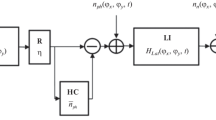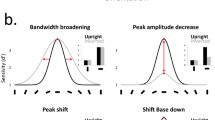Abstract
The aim of the present work was to study the interaction between the optical properties of images of “ disappearing” optotypes and their recognition thresholds. The “disappearing” optotypes were figures with complex outlines and had a unique property-they were close to the threshold of recognition and observation, which increases the accuracy of measurement of visual acuity and the subjects’ attention to them. The recognition distances of “disappearing” optotypes were measured. A relationship was found between the recognition distance of “disappearing” optotypes and different optical density profiles on the one hand and the spatial and spatial frequency characteristics of the stimuli on the other. The decisive factor determining the threshold of recognition of optotypes in spatial frequency terms is its spatial frequency spectrum; that in spatial terms is the width of the black/white pair or black-white triad in the complex outline. Regardless of the shape of the optotype, one of the most important limiting factors was the concordance of this test with the scattering function of the subject’s eye optics.
Similar content being viewed by others
References
K. V. Bardin, Questions of the Threshold of Sensitivity and Psychophysical Methods [in Russian], Nauka, Moscow (1976).
V. V. Volkov, Yu. E. Shelepin, V. B. Makulov, L. N. Kolesnikova, and V. N. Pauk, “New letter-based tests for measurement of visual acuity,” Oftal’mol. Zh., 5, 294–296 (1987).
V. V. Volkov, Yu. E. Shelepin, V. B. Makulov, L. N. Kolesnikova, and V. N. Pauk, Methods for Visual Contrast Perimetry: Methodological Recommendations and Atlas [in Russian], Moscow (1988), p. 14.
S. S. Golovin, Clinical Ophthalmology [in Russian], State Press, Moscow, Leningrad (1923).
S. S. Golovin, Russian Isognostic Tables for Studies of Visual Acuity [in Russian], State Press, Moscow, Leningrad (1925).
S. S. Golovin and D. A. Sivtsev, Tables for Measurement of Visual Acuity [in Russian], State Press, Moscow, Leningrad (1926).
F. W. Cabell and Yu. E. Shelepin, “The ability of the foveola in object discrimination,” Sensor. Sistemy, 4, No. 2, 181–185 (1990).
S. A. Koskin, Yu. E. Shelepin, V. B. Makulov, V. N. Pauk, and N. N. Pavlov, “Conditions for the discrimination of optotypes with defined spatial frequency characteristics,” Sensor. Sistemy, 4, No. 1, 79–83 (1990).
S. A. Koskin, V. V. Khlebnikov, and Yu. E. Shelepin, “Measurement of visual acuity in clinical practice,” Oftal’mokhirurgiya i Terapiya, 2, No. 3, 40–43 (2002).
N. N. Krasil’nikov, Transfer Theory and the Perception of Images [in Russian], Radio i Svyaz’, Moscow (1986).
N. N. Krasil’nikov, Digital Image Processing [in Russian], Vuzovskaya Shkola, Moscow (2001).
M. M. Miroshnikov and V. F. Nesteruk, Iconics. Current State and Directions for Future Development. The Optical-Mechanical Industry [in Russian], Vol. 12, pp. 15–17 (1988).
N. F. Podvigin, Dynamic Properties of Neuronal Structures of the Visual System [in Russian], Nauka, Leningrad (1979).
A. Kholina, “A new table for studies of visual acuity,” Russ. Oftal. Zh., 10, No. 2, 42047 (1930).
K. I. Tsikulenko, “The question of the minimum cognoscible,” Russ. Oftal. Zh., 9, No. 2, 143–145 (1929).
K. I. Tsikulenko “The perception of a point,” Russ. Oftal. Zh., 5, No. 1, 151–156 (1926).
K. I. Tsikulenko “Modification of Landolt’s ring in relation to the effects of irradiation on them, ” Russ. Oftal. Zh., 6, No. 11, 1042–1045 (1927).
I. I. Tsukkerman, “The concordance between the spatial frequency filters of the visual analyzer and image statistics,” Biofizika, 23, No. 6, 1108–1109 (1978).
Yu. E. Shelepin and V. M. Bondarko, “The resolving ability and image discretization in the visual system,” Ros. Fiziol. Zh. im. I. M. Sechenova, 88, No. 9, 1116–1132 (2002).
Yu. E. Shelepin, V. D. Glezer, V. M. Bondarko, and M. V. Pavlovskaya, Spatial Vision. Visual Physiology. (Handbook of Physiology), [in Russian], A. L. Byzov (ed.), Nauka, Moscow (1992), pp. 528–585.
Yu. E. Shelepin, L. N. Kolesnikova, and Yu. I. Levkovich, Visual Contrastometry. (Measurement of Modulatory Transfer Functions of the Visual System) [in Russian], Nauka, Leningrad (1985).
Yu. E. Shelepin, V. V. Volkov, S. A. Koskin, V. B. Makulov, L. N. Kolesnikova, N. M. Kornyushina, and V. N. Pauk, A Means for Studying Visual Acuity and a Test Map for This Purpose [in Russian], A. s. USSR No. 1540798. Priority from 27.4.87. Published 7.2.90, BI No. 5.
Yu. E. Shelepin, V. B. Makulov, L. N. Kolesnikova, V. N. Pauk, N. M. Kornyushina, and Yu. A. Kirillov, A Method for Measuring Visual Acuity and a Test Map for This Purpose [in Russian], A. s. USSR No. 1542545. Priority from 21.4.87. Published 15.2.90, BI No. 6.
Yu. E. Shelepin, N. N. Krasil’nikov, S. V. Pronin, V. B. Makulov, V. N. Chikhman, V. F. Danilichev, and S. A. Koskin, “Iconics and a method for evaluating the functional abilities of the visual system,” Sensor. Sistemy, 12, No. 3, 319–328 (1998).
T. O. Adoh and J. M. Woodhouse, “The Cardiff acuity test used for measuring visual acuity development in toddlers,” Vision Res., 34, No. 4, 555–560 (1994).
F. W. Campbell and Yu. E. Shelepin, “The mechanics of the foveola and its role in defining an object,” Perception, 18, No. 4, 532 (A50) (1989).
F. W. Campbell, Yu. E. Shelepin, N. N. Pavlov, and T. W. Tegeder, “Psychophysical measurements of the intercone separation and object recognition in the human foveola,” Ophthalm. Physiol. Opt., 12, No. 1, 101–102 (1992).
L. Frisen, “Vanishing optotypes. New type of acuity test letters,” Arch. Ophthalmol., 104, No. 8, 1194–1198 (1986).
S. A. Koskin, V. F. Danilichev, and Yu. E. Shelepin, “A comparative study of the spatial-frequency spectrum of different letter optotypes and its role in target recognition,” Perception, 26, Supplement, 54 (1997).
S. A. Koskin, Yu. E. Shelepin, and V. B. Makulov, “Recognition of filtered optotypes with narrow-band spatial-frequency spectrum,” Perception, 27,Supplement, 162 (1998).
R. T. Mackie, K. J. Saunders, R. E. Day, G. N. Dutton, and D. L. McCulloch, “Visual acuity assessment of children with neurological impairment using grating and vanishing optotype acuity cards,” Acta Ophthalmol. Scand., 74, No. 5, 483–487 (1996).
V. B. Makulov and V. N. Pauk, “Software for Image processing on personal computers,” Optical Engineering, 31, No. 4, 782–788 (1992).
A. Medina and B. Howland, “A novel high-frequency visual acuity chart,” Ophthal. Physiol. Opt., 8, No. 1, 14–18 (1988).
M. L. Simas and S. L. Silva, “Vanishing optotypes: is single presentation superior to chart exposure,” Braz. J. Med. Biol. Res., 24, No. 2, 145–148 (1991).
A. B. Watson, H. B. Harlow, and J. G. Robson, “What does the eye see best?” Nature, 302, No. 5907, 419–422 (1983).
H. R. Wilson and D. J. Gelb, “Modified line element theory for spatial frequency and width discrimination,” J. Opt. Soc. Amer., A1, 124–131 (1984).
H. R. Wilson, D. K. MacFarlane, and G. C. Phillips, “Spatial frequency tuning of orientation selective units estimated by oblique masking,” Vision Res., 23, 873–882 (1983).
“Recommended standard procedures for the clinical measurement and specification of visual acuity. Report of working group 39. Committee on Vision. Assembly of Behavioral and Social Sciences, National Research Council, National Academy of Sciences, Washington D.C.,” Adv. Ophthalmol., 41, 103–148 (1980).
Author information
Authors and Affiliations
Additional information
__________
Translated from Rossiiskii Fiziologicheskii Zhurnal imeni I. M. Sechenova, Vol. 91, No. 9, pp. 1080–1090, September, 2005.
Rights and permissions
About this article
Cite this article
Koskin, S.A., Boiko, É.V., Sobolev, A.F. et al. Mechanisms of recognition of the outlines of “vanishing” optotypes. Neurosci Behav Physiol 37, 59–65 (2007). https://doi.org/10.1007/s11055-007-0150-0
Received:
Issue Date:
DOI: https://doi.org/10.1007/s11055-007-0150-0




